-
 Fix the Hypervisor Error in Windows 11 with 4 Easy Ways
Fix the Hypervisor Error in Windows 11 with 4 Easy Ways January 23,2025
January 23,2025 6 min read
6 min read -
 Windows Cannot Find GPEDIT.MSC on Windows 11/10, Fixed Now!
Windows Cannot Find GPEDIT.MSC on Windows 11/10, Fixed Now! January 23,2025
January 23,2025 6 min read
6 min read -
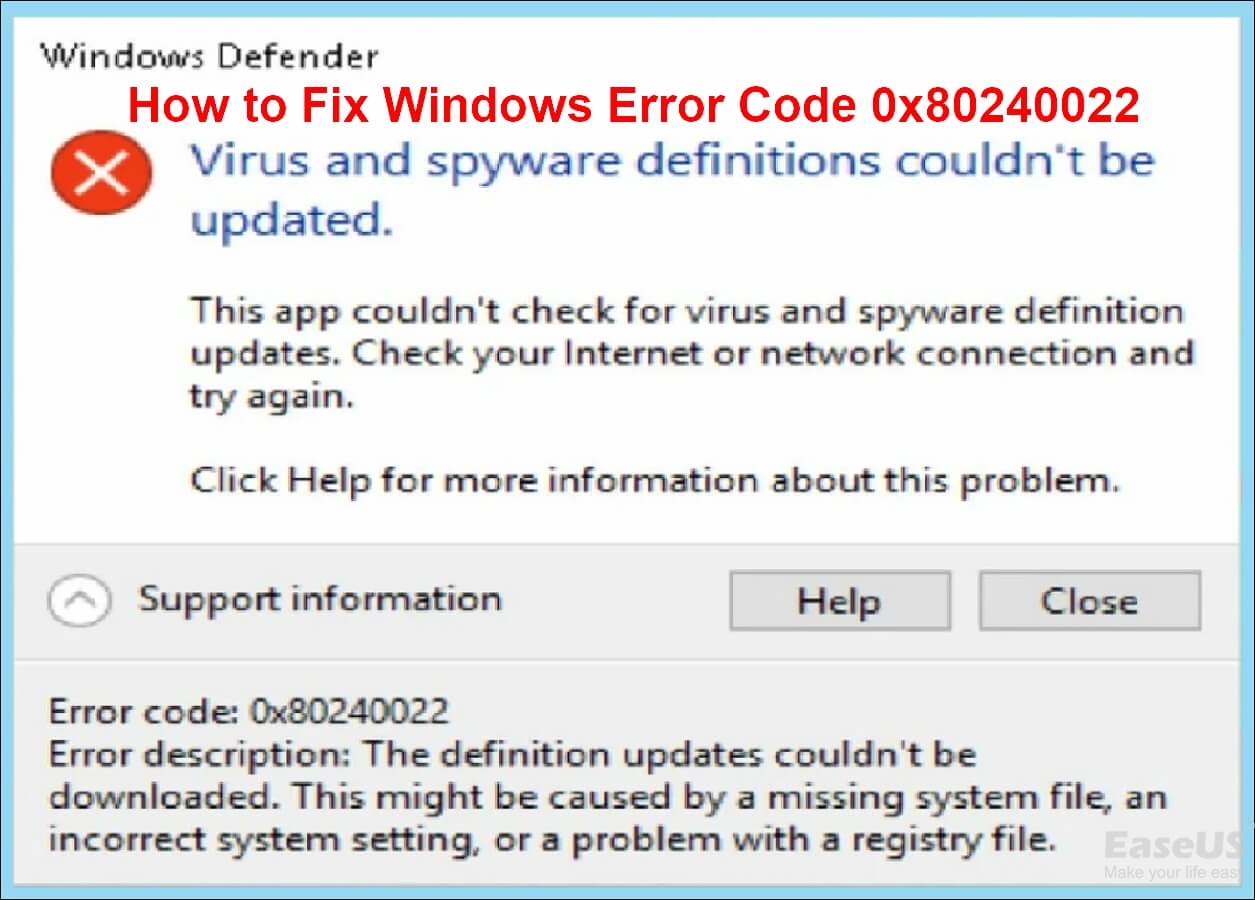 [Solve Windows Defender Error] Fix Windows Error Code 0x80240022
[Solve Windows Defender Error] Fix Windows Error Code 0x80240022 January 23,2025
January 23,2025 6 min read
6 min read -
 5 Ways | How to Fix Data Error Cyclic Redundancy Check
5 Ways | How to Fix Data Error Cyclic Redundancy Check January 16,2025
January 16,2025 6 min read
6 min read -
 How to Fix The Disk Structure Is Corrupted and Unreadable
How to Fix The Disk Structure Is Corrupted and Unreadable January 16,2025
January 16,2025 6 min read
6 min read -
 How to Fix External Hard Drive Takes Long Time to Open and Read
How to Fix External Hard Drive Takes Long Time to Open and Read January 16,2025
January 16,2025 6 min read
6 min read -
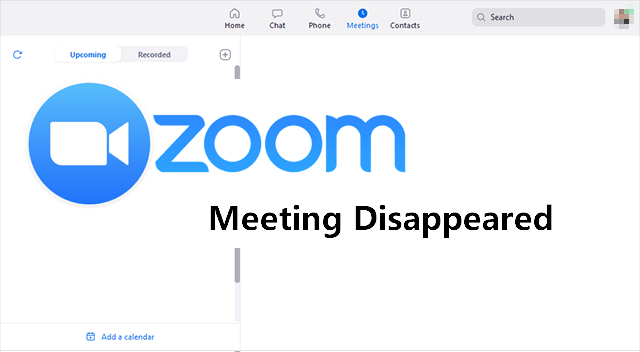 Zoom Meeting Disappeared for No Reason? Fix It and Recover Zoom Meetings Now
Zoom Meeting Disappeared for No Reason? Fix It and Recover Zoom Meetings Now January 23,2025
January 23,2025 6 min read
6 min read -

-
 Your PC Ran Into a Problem and Needs to Restart in Windows 10/11
Your PC Ran Into a Problem and Needs to Restart in Windows 10/11 January 16,2025
January 16,2025 6 min read
6 min read -

Page Table of Contents
Why Are My Files Not Showing Up in Internal/External Hard Drive
How to Fix Hard Drive Not Showing Files Though They Still Exist
Now, You Are Good To Use the Hard Drive and Files
FAQs About Files Not Showing in Hard Drive
| Workable Solutions | Step-by-step Troubleshooting |
|---|---|
| 1. Reconnect Hard Drive | Reconnect the internal or external hard drive on your computer...Full steps |
| 2. Recover data or Show Hidden Files | Run EaseUS Data Recovery Wizard and choose the exact external hard drive where you lost files...Full steps |
| 3. Fix Internal/External Hard Drive | Type cmd in the Windows search box, right-click on "Command Prompt" and choose...Full steps |
On this page, we'll take "hard drive not showing files though they still exist" as an example to show you how to easily fix such a problem and restore all missing files from your internal or external hard drive.

Ensure you review the whole guide, get all deleted files back, and make the drive work normally again.
Why Are My Files Not Showing Up in Internal/External Hard Drive
Quite a lot of Windows users reported that their local hard drive, external drive, USB flash drive, pen drive, or memory card was showing up in Windows File Explorer, but they couldn't see the files and folders when they opened the device.
So why can't I see files and folders saved to my external drive in the Windows operating system? Check out the causes first.
Causes of Files Not Showing in External Hard Drive Though They Still Exist Issue
"Hard drive not showing files though they still exist" error frequently occurs that many factors may cause your storage device contents to disappear without being noticed, such as:
- The power supply is not stable
- File system errors that make the entries to your files inaccessible
- The files and folders are hidden, and you disable "show hidden files"
- Virus or malware hides, deletes, or encrypts the files on your hard drive
- Others include hardware issues, hard drive getting corrupted, and more
So, how do I find missing files stored on my hard drive? Follow through the below 3 stages with detailed steps. You will find all existing or missing files from your internal or external hard drive on your own.
How to Fix Hard Drive Not Showing Files Though They Still Exist
It doesn't matter if you can't identify the specific reason that causes your drive not to show files. Finding a reliable way to show up or find the existing files should be your first concern.
To fix the error "data not showing in hard drive" or "files not showing in external hard drive" and bring back all your files immediately, we divided the whole process into three stages, as shown below:
- #Stage 1. Reconnect the External Hard Drive
- #Stage 2. Recover Data or Make Files Showing Up in External Hard Drive
- #Stage 3. Fix Internal/External Hard Drive to Work Normally
As shown below, the whole procedure also works to fix files or data not showing in USB flash drives, SD memory cards, etc., devices. Let's start finding and restoring all missing files from your hard drive or external hard drives now.
#Stage 1. Reconnect the External Hard Drive to Make Files Show Up
Applies to: Fix internal/external hard drive files not showing up due to unstable power supply.
Sometimes, when your internal or external hard drive connection is loosened, the device cannot show up the saved files on your computer. So the best way out is to reconnect the drive and make files show up again.
Step 1. Reconnect the internal or external hard drive on your computer.
To Reconnect the Hard Drive:
- Shut down the PC and open the computer case with a screwdriver.
- Check the power cable and SATA cable. If they are broken, change with a new one.
- Reinstall it to the PC via its power cable and SATA cable, tighten the wires and computer case, and restart the PC.
To Reconnect the External Hard Drive:
- In the Windows File Explorer, right-click to eject the external hard drive.
- Check the USB cable; if it's broken, change it to a new one.
- Connect the external hard disk to the PC tightly via the USB cable.
Step 2. Check if files show up on the external hard drive.
Open the Windows File Explorer, and check to open your internal hard drive or external drive and see if files show up.
If not, move to Stage 2 and follow the tutorial steps to bring all your hard drive files back easily.
#Stage 2. Recover (Not Showing) Files or Make Files Showing Up in External Hard Drive
Applies to: Restore missing, hidden, not showing files due to device file system error, file hidden, or data removed by viruses.
As stated above, many factors may cause your hard drive files to be missing. For example, the virus infection that deletes or hides your files from showing up. To recover missing files, here you have 4 methods to try:
- Method 1. Use File Recovery Software - Easiest
- Method 2. Show Hidden Files Folders
- Method 3. Use CMD
- Method 4. Using CMD Alternative
For the easiest solution, EaseUS Data Recovery Wizard can give you the best solution.
Method 1. Recover Missing Files with File Recovery Software
EaseUS file recovery software - Data Recovery Wizard can help you recover files and folders that can't be seen on an internal or external hard drive in Windows 11/10/8/7. It's an all-in-one solution to recover missing files.
- Recover lost files, documents, photos, audio, music, and emails effectively.
- Recover files from formatted hard drive, emptied Recycle Bin, memory cards, flash drives, digital cameras, and camcorders
- Recover deleted files over 1000 file types like DOC/DOCX, XLS/XLSX, PPT/PPTX, AIF/AIFF, M4A, MP3, JPG/JPEG, AVI, MP4, and more.
Follow to retrieve all existing or missing files that are hidden, removed, or inaccessible on your hard drive with ease now:
Step 1. Use a correct USB cable to connect your external hard drive to your computer. Run EaseUS Data Recovery Wizard and you will see your external disk under External drives. This software supports all the popular external disk brands, including WD, Seagate, Toshiba, LaCie, SanDisk, Samsung, etc.
Select the external hard drive and then click the "Search for Lost Data" button.
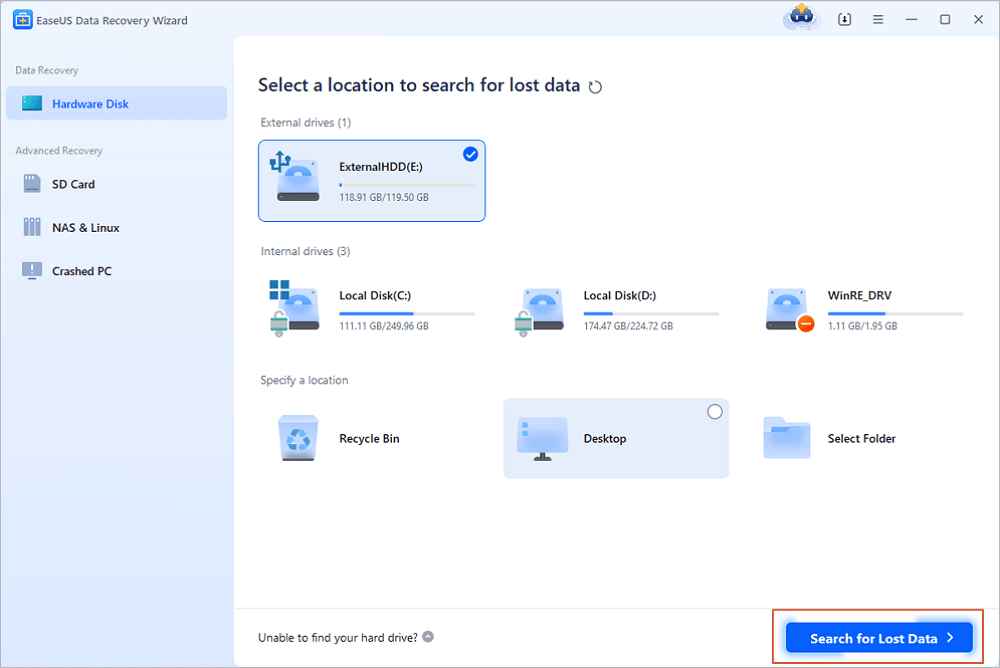
Step 2. As soon as the scan process starts, the software will find more and more lost and deleted data and display the data in the scan results. The recovered data will be nicely organized. You can quickly find the target files/folders by file type or search in the search box with exact file name.
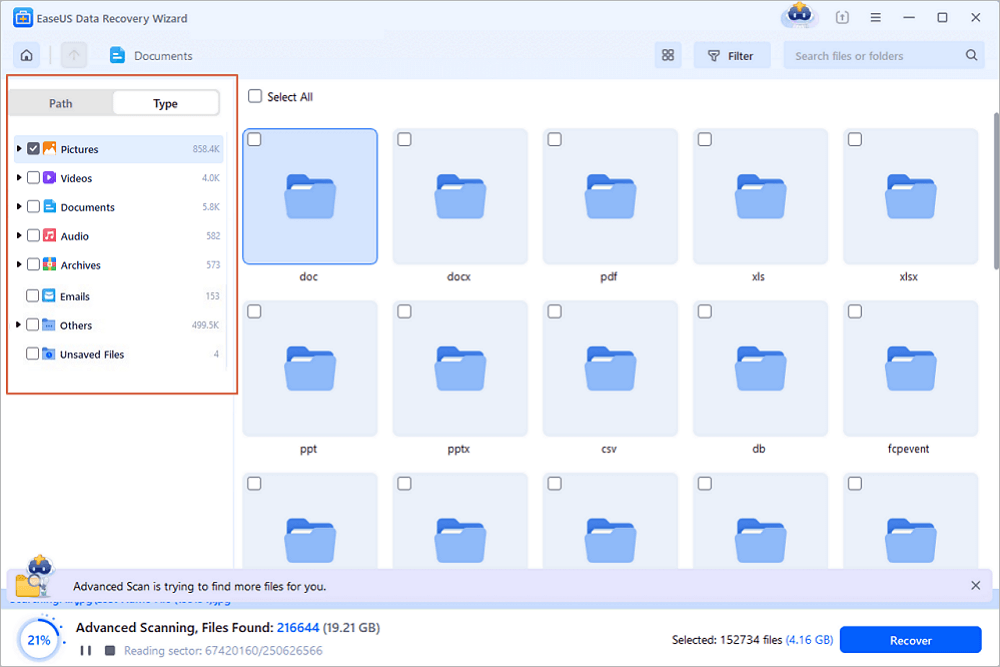
Step 3. You can preview the files found by EaseUS Data Recovery Wizard's scanning algorithms. Then, select files and click "Recover". To avoid data overwriting, we recommend that you save the recovered data to a different drive than the original Seagate drive.
💡Tip: You can restore data on the local disks, external hard drives, and also the cloud storage.
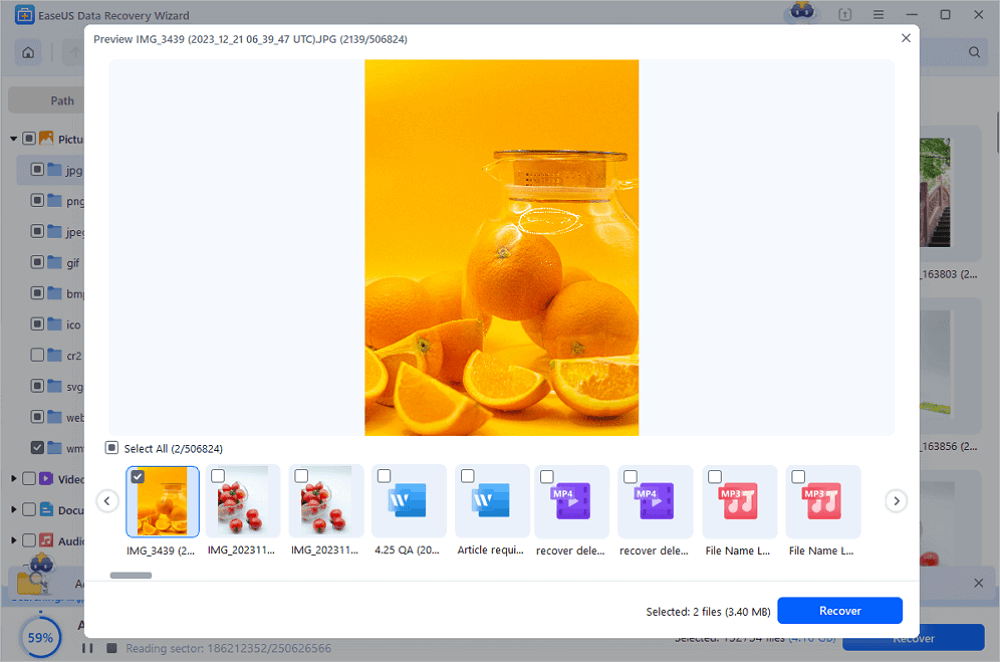
Don't save the recovered files to your original drive. Then, move to Stage 3 to repair your drive, making it viable and secure for saving files again.
You can also check this video tutorial to see how to show your external hard drive files.

Method 2. Show Hidden Files in Hard Drive or External Hard Drive
To protect some confidential files, people tend to hide them from showing up on storage devices. If you did so or accidentally hid them in your drive, you would encounter the hard drive not showing files, though they still exist issue.
So the best way out is to unhide them. Here are the steps to show hidden files on your hard drive or external hard drive:
Step 1. Double-click "This PC" to open File Explorer.
Step 2. Locate and double-click to open your hard drive or external hard drive.
Step 3. Go to the "View" Tab. In the Show/hide section, check "Hidden items".

After this, you will be able to check the hidden or missing files on your hard drive again.
Also Read: Show Hidden Files on USB and Memory Card.
Method 3. Retrieve Files that Were Hidden/Deletes by Virus Using CMD
According to some users, sometimes viruses or malware may cause a "file loss" issue on your hard drive. For example, a shortcut virus would hide the original data, creating a shortcut of the files displaying on your drive.
To restore the files that are hidden by viruses or malware, run the CMD command lines shown below:
Step 1. Run antivirus software to clear viruses and malware on your hard drive and PC.
Step 2. Connect the external hard drive to your PC if files are not showing on it.
Step 3. Type cmd in the Windows Search box, right-click Command Prompt, and select "Run as Administrator".
Step 4. Type the following command lines and hit enter each time:
- E (Replace E with the drive letter of your hard drive or external disk that is not showing files.)
- del *.lnk
- attrib -s -r -h *.* /s /d /l

Step 5. Type exit when the process completes.
To recover hidden files from a hard drive using CMD:
Step 1. Press the Windows + S keys, and type cmd in the Windows Search box.
Step 2. Right-click Command Prompt, select "Run as Administrator".
Step 3. Type the command line attrib -h -r -s G:\*.* /s /d and hit Enter.
The command will show all hidden files on your device. You can open the device to check them now.
Step 4. Type exit to close the command prompt.
Method 4. Find Hidden Files on Hard Drive Using CMD Alternative
Manual execution of the command line is suitable for computer professionals, since incorrect commands can do more harm than good. Therefore, for security and usability, we strongly recommend you try an automatic command line alternative - EaseUS CleanGenius. It is a practical tool that enables you to check and fix file system errors, enable/disable write protection and update your system with one-click instead of typing intricate command lines.
Follow the simple steps below to show hidden files with this 1-click-fix software.
Step 1. DOWNLOAD EaseUS CleanGenius for Free.
Step 2. Start EaseUS CleanGenius, choose "Optimization" on the left panel. Next, click "File Showing" on the right panel.

Step 3. Select the hard drive and click "Execute".

Step 4. After the operation completes, click the here link to check the hidden files.

After this, you can reconnect your device to the computer and check if the hidden files show up.
Note that this is not the end. You still have one last move to go, which is to fix the device error, making your hard drive available for saving data again. Check out how to fix your hard drive device error in Stage 3.
#Stage 3. Fix the Device Error and Format to Reset the Hard Drive
Applies to: Fix file system error that causes files to be inaccessible on a hard drive or external hard drive, and reset the device to usable again.
If you can't see files or folders on the external hard drive or the USB pen drive is not showing data files due to file system errors or file corruption, you can try the following two tips to make your drive show files and work normally again:
#1. Using Command Prompt to Fix Internal Problems on Hard Drive
- Warning
- Running chkdsk can hopefully fix the hard drive errors. However, it can also result in total data loss. So, perform data recovery in advance and then continue with the CMD method.
Step 1. Type cmd in the Windows search box, right-click on "Command Prompt" and choose "Run as administrator".
Step 2. Type chkdsk g: /f and hit Enter.
"g" is the drive letter, so please replace it with the drive letter of your external hard drive.
CHKDSK command will scan and repair drives once it finds any corruption.

Step 4. Type exit when the process completes.
Now, you go to the next guide to format the hard drive or external hard drive to reset its file system to NTFS or exFAT, making the device secure to save and show files again.
As formatting will cause file loss, remember to let EaseUS Data Recovery Wizard scan your whole drive, finding all missing data first.
#2. Format or Reformat Hard Drive/External Hard Drive
To make the hard drive or external hard drive work normally without any issues, we recommend you format your hard drive to Windows-supported format in Disk Management. NTFS is recommended for a hard drive.
Refer to the steps here to make your device usable again:
Step 1. Connect the external hard drive to your PC.
Step 2. Right-click "This PC" > Select "Manage" > "Disk Management".
Step 3. Right-click on the target drive or partition and click on "Format".

Step 4. Select the file system as "NTFS", click "Quick Format" and click "OK" to format the drive.
Now, your device is available for saving data, and you may save the found files back to your external or internal hard drive again.
Now, You Are Good To Use the Hard Drive and Files
When your hard drive is not showing files, though they still exist in the Windows operating system, try reconnecting the drive to your computer first and use the above methods to solve the issue.
If you can't see the files, hard drive data recovery software - EaseUS Data Recovery Wizard can help. It is the easiest way for you to try to bring back all the files.
After restoring the files that are not showing, you can run the CHKDSK command to fix the hard drive error and reformat the device to NTFS to save the data again.
FAQs About Files Not Showing in Hard Drive
If some of you have more questions about the hard drive not showing file issues. Check the questions and answers below, and you may find the desired answers here:
1. What is taking up space on my hard drive in Windows 10/8/7?
How do you see what's taking up space on PC in Windows 7/8/10? You have two steps to go:
Step 1. Show hidden files on the hard drive.
You may revert to Method 2 in Stage 2 for help.
Step 2. Analyze the hard drive and find what's taking up space on your hard drive:
- Go to "Settings" > "System" > "Storage".
- Click on your hard drive partition to see what's taking up the most space.

You may refer to What Is Taking Up Space on My Hard Drive for more details.
2. How do I show hidden files on my external hard drive in Windows 10/11?
- 1. Open File Explorer and go to the Video tab.
- 2. Click Options and choose the "Change folder and search" options.
- 3. On the View tab, look for the Advanced settings area.
- 4. Check "Show hidden files, folders, and drives" and click "OK".
3. How do I fix my external hard drive not recognized error?
When an external hard drive becomes unrecognizable, it may be caused by a working USB port, the hard drive driver, a virus attack, or a device failure error.
You can try the five ways to fix it:
- Try a different USB
- Uninstall and reinstall the external hard drive driver
- Turn on the USB Root Hub
- Show all hidden files
- Use Registry Editor
You may refer to Fix Seagate External Hard Drive Not Detected/Recognized for help.
Was this page helpful?
-
Brithny is a technology enthusiast, aiming to make readers' tech lives easy and enjoyable. She loves exploring new technologies and writing technical how-to tips. In her spare time, she loves sharing things about her game experience on Facebook or Twitter.…
-
Evan Galasso is a digital forensics and data recovery engineer with over 10 years of experience in the field. He presents opinions on the current state of storage media, reverse engineering of storage systems and firmware, and electro-mechanical systems of SSDs and HDDs.…

20+
Years of experience

160+
Countries and regions

72 Million+
Downloads

4.8 +
Trustpilot Score
Hot Recovery Topics
Search




